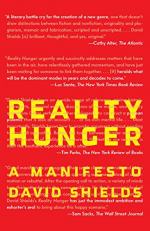|
This section contains 662 words (approx. 2 pages at 400 words per page) |

|
Reality Hunger Summary & Study Guide Description
Reality Hunger Summary & Study Guide includes comprehensive information and analysis to help you understand the book. This study guide contains the following sections:
This detailed literature summary also contains Topics for Discussion on Reality Hunger by David Shields.
The following version of this book was used to create this study guide: Shields, David. Reality Hunger. Vintage, 2011.
The work is, as the author describes it, a mixture of his own writing, opinion and analysis, juxtaposed with writings taken from other sources. There is no indication, in the text itself, from which source a piece of writing has emerged. In other words, material from writers other than the author is not cited. There is, however, an index that the author, as he describes it, was forced to include for legal reasons. This analysis will use terminology such as “the text” to evoke this sense of the work’s collage-like nature. When there is a reference to “the author,” it is to indicate that the ideas or sections in question are, according to information from the index, the author’s own.
The title of each book’s chapter consists of a lower-case letter of the alphabet, and a sub-title. When chapter titles appear in this analysis, they reflect this aspect of the book’s structure and content.
The book begins with the prologue-like chapter a, in which the author begins with a commentary of his own composition which suggests that in every work of art, its creator has attempted to layer in his, her, or their version of what is real, and true. He then offers several examples of writers and works that have attempted to do so. As he does, he establishes the book’s overall form and structure – it is being shaped more along the lines of a textual collage, in which meaning is to be interpreted from juxtapositions of ideas rather than explanation and/or linear narrative. In terms of content, and within this collage-like form, the author goes on to offer different examples of how the book to follow will explore the relationship between reality and art.
In the remainder of the book, the text continues the collage-like structure as it begins a chapter-by-chapter analysis of different aspects of its overall argument. There is commentary suggesting that in art, personal explorations of what it means to be alive are more meaningful and truer to life than fictionalized narratives that rely more on structure and plot to create a sense of story, and of meaning. There are repeated arguments that the literary genre of memoir is ultimately the most effective literary form in terms of communicating the realities of being alive, with particular attention paid to the relatively new genre of the lyric essay. That genre, the text argues, integrates aspects of poetry with aspects of what the text calls “reportage,” or the presentation of facts, of events as they happened and as they are interpreted or understood by the writer.
At the same time, the text presents analysis and commentary on how important it is that artists of any discipline have the freedom to use the work of other artists in their own creation without restriction, or responsibility of identifying the source of the utilized work. The text cites several examples of art forms that follow this practice both regularly and innately, paying particular attention to how hip-hop music is shaped and presented.
In a couple of chapters, the author focuses entirely on his personal experiences and perspectives. In chapters like t, “alone,” and y, “manifesto,” he offers commentary in his own words. He still following the book’s basic collage-like structure, but focuses on adding meaning, argument, and analysis by juxtapositions between his own ideas and experiences and those of other writers.
As the book concludes, the text challenges both readers and other writers to engage with its arguments. It continues to advocate for both looking for and creating art that breaks the boundaries of story and structure. It also urges that writers and readers alike focus on exploring considerations of meaning rather than on the shaping of story since, the book argues, the offering of such considerations is what the creation of art is for.
Read more from the Study Guide
|
This section contains 662 words (approx. 2 pages at 400 words per page) |

|



